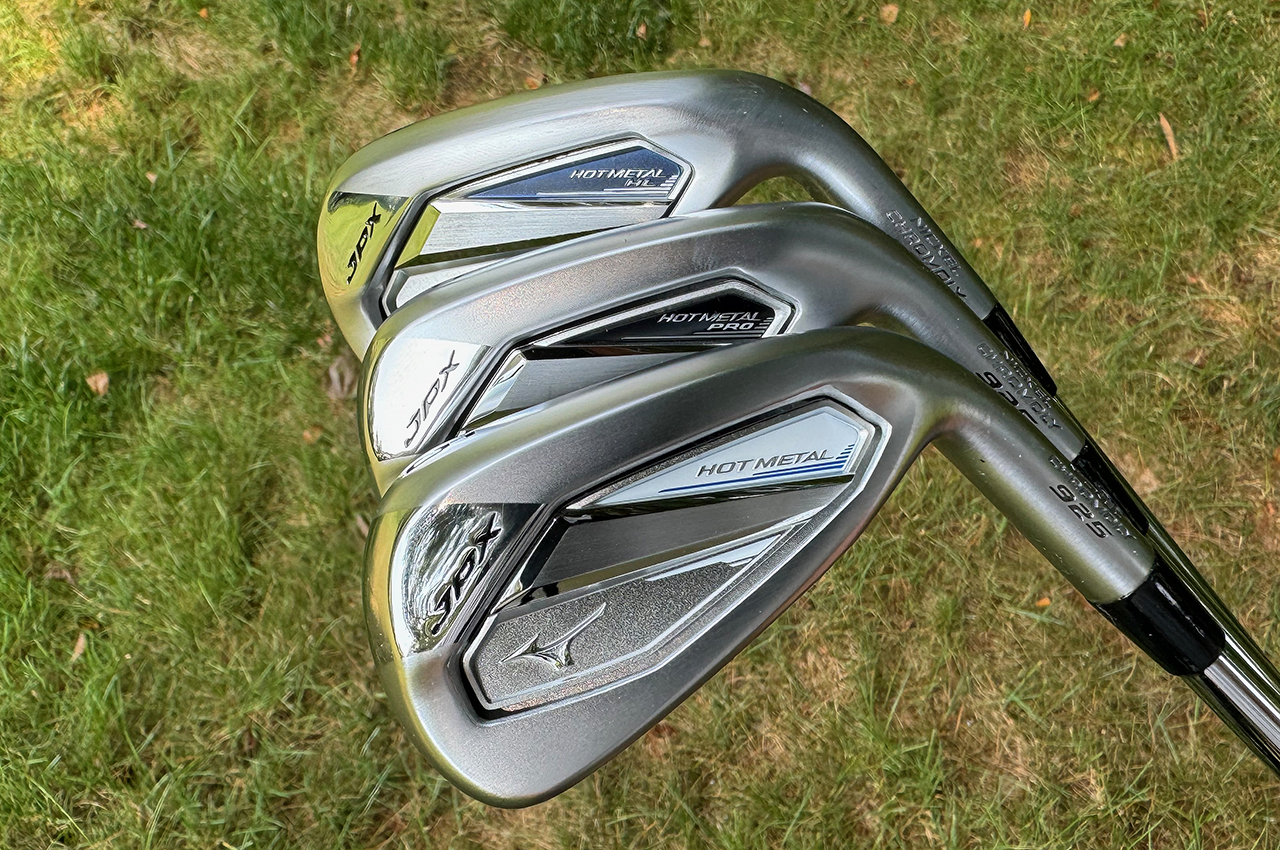Gear: Mizuno JPX 925 Hot Metal, Hot Metal Pro, Hot Metal HL irons
Price: $150 per club with Nippon N.S. Pro 950 NEO steel shafts and Lamkin UT+ grips (Hot Metal)
Specs: Forged stainless steel body with Nickel Chromoly 4335 cup face and internal tungsten weight.
Available: Sept. 5 (pre-sale), Sept. 19 (in stores)
Who It’s For: Golfers who want more ball speed and forgiveness (Hot Metal), accomplished players who want a better-player’s distance iron (Hot Metal Pro) or moderate- and slower-swinging golfers who want more height and carry distance from their irons (Hot Metal HL).
What you should know: Each of the three new JPX Hot Metal irons – the standard, HL (high launch) and Pro – feature thinner faces that offer a larger sweet spot and more ball speed on mishits, while also delivering the feel and sound that golfers expect from a Mizuno iron.
The Deep Dive: Mizuno has invested significant time and resources to make better woods over the last few seasons, resulting in clubs like the ST-Max and ST-G drivers, but most golfers still think of the Japanese brand as an iron company. That’s not a bad thing because the Mizuno Pro 241, Mizuno Pro 243 and Mizuno Pro 245 irons are extremely popular with golfers who love classic-looking blade-style irons that enhance feel.
The JPX Series irons have been popular with elite players, but JPX irons are also where Mizuno blends unique technologies and design elements to boost forgiveness and distance, often making them more playable for a wider number of golfers.
The new Mizuno JPX 925 Hot Metal, Hot Metal HL, and Hot Metal Pro irons continue that tradition, thanks to an updated face design and internal changes that should make it easier for players to hit longer, higher shots.

Using Nickel Chromoly allowed Mizuno to make the hitting area thinner across a larger portion of the face. (David Dusek/Golfweek)
While each club in the Mizuno Pro family is forged, the JPX 925 irons are all cast using Nickel Chromoly 4335, an extremely strong alloy. Nickel Chromoly was introduced in the JPX 923 irons and is significantly stronger than the standard Chromoly Mizuno has used. This allows engineers to redesign the cup-face hitting area to be thinner.
In the JPX 923 4-iron through 8-iron, the hitting area was 2.05 millimeters thick in the center and thinned to as little as 1.75 millimeters to allow a larger portion of the face to flex at the moment of impact. Now, in the JPX 925 irons, a tiny area in the center of the face is thick (2.4 millimeters), but a larger area around it is thinned to just 1.2 millimeters.
Mizuno refers to this new multi-thickness design as a CORTECH face. This cup face is complemented by a thinner leading-edge area that flexes more efficiently and allows the whole face to bend more at impact.
The thinner face design and the thinner leading edge should result in more ball speed and distance, especially on mishit shots.

An internal tungsten weight helps to create a higher launch angle in the long irons while a thinner leading edge allows the whole hitting area to flex more efficiently. (David Dusek/Golfweek)
The 4-iron through 7-iron in the JPX 925 series have also been given 11-gram internal tungsten weights. By positioning the weights low and forward but not allowing them to touch the back of the face, it should be easier to start shots on a higher launch angle and bring them down on a steeper angle of descent for increased stopping power and distance control.
Mizuno designers also added a series of reinforcing ribs under the topline to stiffen that region of the club. When combined with a new bar that goes across the back, this attunes the JPX 925 irons to sound and feel more solid and pleasing at impact.

The JPX 925 Hotel Metal Pro (left) has the thinnest topline and least offset, while the Hot Metal HL (right) has the most. (David Dusek/Golfweek)
There are three different versions of the JPX 925 Hot Metal iron. The standard is a game-improvement iron offered from 4-iron through sand wedge for both right- and left-handed players that should appeal to a wide variety of golfers. Its lofts are strong, with the 5-iron at 22 degrees and the pitching wedge at 42 degrees.
The JPX 925 Hot Metal Pro, which is also available for right- and left-handed players, has a shorter blade length, thinner topline, and less offset, making it appealing to slightly better golfers. However, it has the same lofts as the standard Hot Metal irons, so golfers should easily be able to create a blended set by working with a custom fitter.
The JPX 925 Hot Metal HL is for moderate and slower-swinging golfers who want to maximize carry distance and get more height on their shots. To help them do that, Mizuno weakened the lofts, so the HL’s 5-iron has 25 degrees of loft, and the pitching wedge has 45. The JPX 925 Hot Metal HL is only available in a right-hand version.
Below are several close-up images of the JPX 925 Hot Metal, Hot Metal HL and Hot Metal Pro irons.

Share this

Share this

Share this

Share this

Share this

Share this

Share this

Share this

Share this

Share this

Share this

Share this

